Arts & Entertainment Community
Gig Harbor Now and Then | Lawrence of Purdy
A sign of history
Earlier this year, Gig Harbor Now columnist Tonya Strickland and I started a series of stories titled Behind the Finds. They explore the lives of people in photographs found in random places. This entry in Gig Harbor Now and Then is so similar, it could be called Behind the Signs.
There is a street sign in Purdy that has two tales of history behind it. Today’s column will explore both.
The sign is mounted at the east side of the intersection of 154th Street and Purdy Drive. It reads, in white letters on a brown background, “Historic Road Name/Lawrence Rd.”
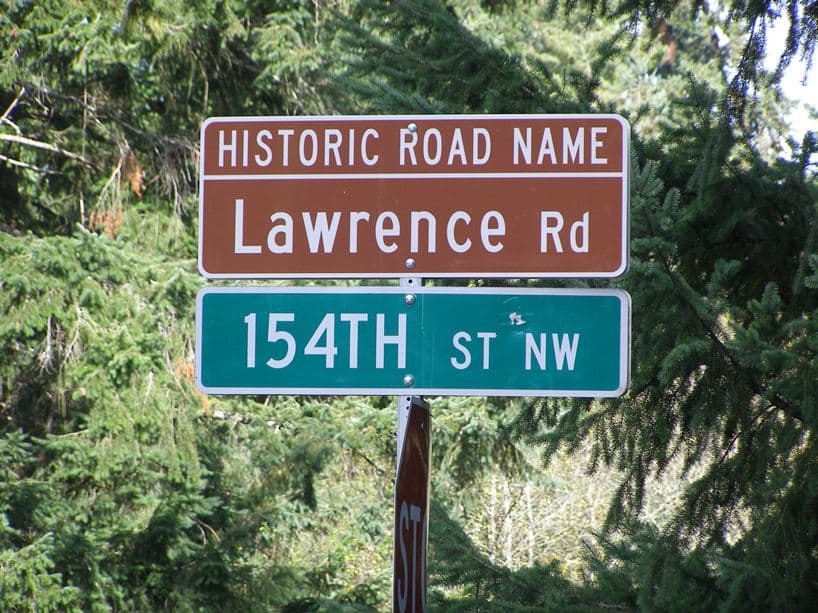
So which is it?
An explanation of the sign will come later. First, we’ll talk about how the Lawrence Road was named.
The Lawrence behind the sign
In every community, there are individuals who make outsized positive impacts on the lives of their neighbors. They are not always the most visible and vocal movers and shakers who reap the majority of the recognition. In many cases they are simply hard-working people who see needs to be filled and fill them as a matter of course, whether in their business lives or through volunteerism and charitable contributions. Less common is when entire families fill those community needs.
The Lawrence for whom the old road was named was not an individual, but an entire family. The patriarch of the family was Henry Lawrence, most commonly known in newspaper mentions and advertisements as H.M. Lawrence. He and his wife Ida raised seven children.
Henry Lawrence was a go-getter. The tale his newspaper trail tells us is that he was a businessman of many talents. He was also a deal maker. He believed strongly in barter, knowing that value is not restricted to a defined amount of cash.
The Lawrence family moved to Tacoma from Ohio in about 1906, with their first inclusion in the city directory coming in 1907. The directories show they moved around a bit, but within the small, general area of South 64th and South J streets, east of Wapato Lake. In every listing, he is a carpenter.
One of the places the Lawrence family lived in South Tacoma was at the southwest corner of South 64th and J. It was not quite nine-tenths of an acre, for which they paid $600, with a down payment of $400, in 1906. On part of it they built a 22-by-24 foot cottage in December 1909. Today it’s the site of a Tacoma Power substation at 1006 South 64th Street.
An excursion to the Peninsula
In August 1911, the family spent a week at Purdy, most likely on a camping vacation. They bought their first property there on April 12, 1912, from Jimerson and Gladys Hamilton (Jimerson!). They didn’t move to the new property right away, and still lived in South Tacoma in November 1912, when Ida Lawrence made the newspaper for attending a church’s ladies’ aid meeting there.
The Lawrences’ last appearance in the Tacoma city directory was in 1913, which is likely the year they moved to Purdy, where they had built a log home. They definitely lived there in 1914, when an advertisement they placed in a Tacoma newspaper to sell a house gave their point of contact as Gig Harbor (Purdy was by then served by the Gig Harbor post office).
The log house Henry built for his family was on what is now 154th Street, where Cedars Mobile Manor now stands.

Cedars Mobile Manor.
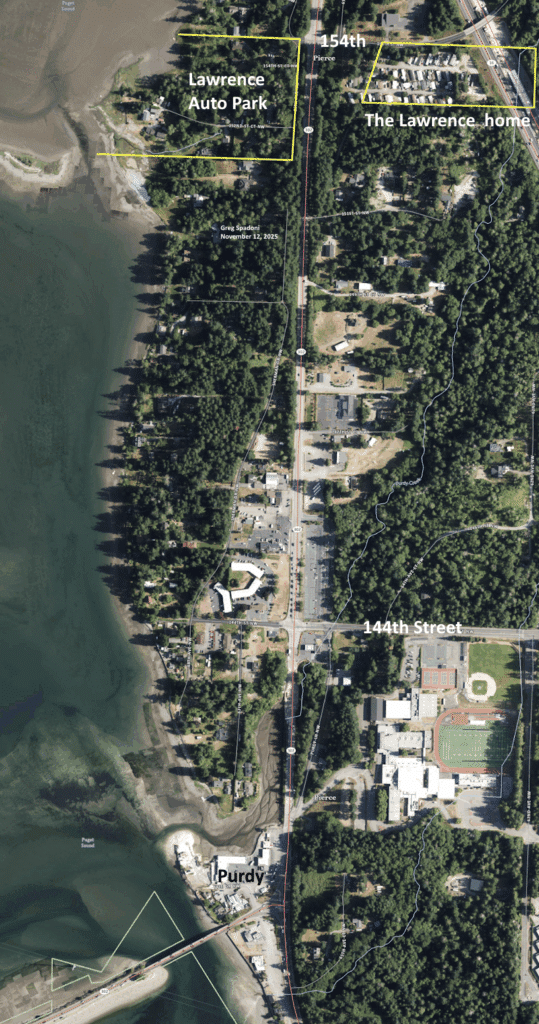
Pierce County Assessor-Treasurer aerial base map.

Pierce County Assessor-Treasurer aerial base map.
Carpentry and farming
It appears that Henry Lawrence was seriously into farming during his early years in Purdy. He was listed as one of the attendees at a Bay-Island farmers meeting in 1916, and he rented the farm of Henry Kaughenberg in 1920. (The Gig Harbor and Key Peninsulas were part of the loosely defined Bay-Island district in the early part of the 20th century.)
In addition to farming, Henry continued his primary occupation as a carpenter after he moved to the Peninsula. Some of his work was mentioned in the local weekly newspaper, The Bay-Island News, which began publication in 1917. Among the highlights from the teens and twenties are:
- Henry built an addition onto the Burley post office in August 1918. That November, he remodeled the Burley Store.
- Along with Frank Allen, Henry built a “good sized” evaporating plant in Burley for the Reverend A.B. Ellis in June 1919. It was used for drying fruit. In August, Henry and one of his sons built a house for Mr. and Mrs. W.E. White where the old Wauna store had been, on the hill across the road from the Wauna store on the waterfront. It would be known as the Wauna Lodge, and would host short-term boarders.
- In 1920, he remodeled the Burley Store again.
- Henry made a cabinet for Fred Forrest’s record player out of used material in 1921, which earned him two sentences in the Bay-Island News: Lawrence of Purdy delivered a cabinet for a Victrola to Mr. Forrest, made from an old organ. It shows what Mr. Lawrence can make from any old thing.
- Also in The Bay-Island News in 1921, Carpenter H. Lawrence of Purdy is finishing Mrs. White’s little house, and Goldman is having a new garage built. Mr. Lawrence of Purdy is the carpenter.
- In 1922, Henry worked on the Anderson Store at Purdy, built an addition to the Ferry Lunch restaurant at North Gig Harbor, and constructed a house for Gig Harbor businessman Clarence Luters in Wauna.
- Elwin Nichols, a logger and prominent citizen of Glencove, hired Henry and a son (probably Malcolm) to build him a new barn.
Beyond carpentry and farming
Henry Lawrence was not a man who could sit still for long, if at all. In addition to his carpentry and farming, he steadily added new lines of business to his family’s affairs, employing more than one of his sons in several of them.
In 1921 the family diversified its businesses by starting the Bay-Island & Tacoma Transfer Co.
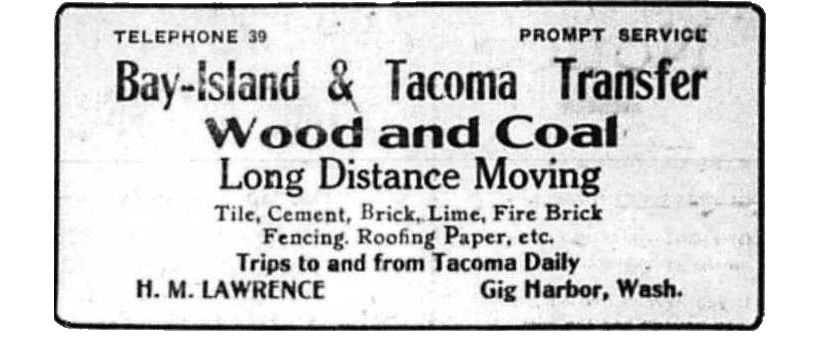
The Bay-Island News, June 17, 1921.
The idea for the hauling and transfer business may have been a good one, but it held dire consequences for the Lawrence family. Their second son, Kenneth, developed severe kidney disease from the constant, harsh, jarring ride of the solid-rubber-tired truck on rough, unpaved roads. He died at 20 years old in 1922.
Henry attempted to sell the brutal-riding truck in August 1921, either separately or together with the transfer business.

The Tacoma Daily Ledger, Aug. 14, 1921, page 20.
Whether he was able to sell the business, no further mention of the company was found beyond December 1921, when they were selling Christmas trees.

The News Tribune, Dec. 6, 1921, page 18.
With the coming of the new year, Henry and sons moved on to other things.
Real estate
More diversification came in 1922, when Henry and his oldest son, Clarence Malcolm Lawrence (who used his middle name instead of his first), opened a real estate office next to the ferry landing in North Gig Harbor.

The Bay-Island News, Sept. 15, 1922, page 2.
In August of the same year, The News Tribune reported that: “Owing to the prolonged illness of one of the members of the Peninsula Realty Co., H. M. Lawrence & Sons have taken over the entire real estate business and have moved their office from the Ferry landing to their home in Purdy.”
That’s the last mention found of the Peninsula Realty Co., but the Lawrences continued to buy, develop, and sell real estate for years to come.
Fuel for sale
The first newspaper mention of the Lawrences branching out into cordwood (firewood) was a single sentence in the Dec. 26, 1919, issue of the Bay-Island News from its Purdy correspondent: “Our neck of the woods echoes and reechoes with the chug of Mr. Lawrence’s new drag saw; most of his neighbors are going to be prepared for the next cold snap.”
(A drag saw was the first practical gasoline-powered saw for use in the woods. It was propped up on a log, not hand held.)
The Lawrences’ first use of the new drag saw was for their own needs. By 1921 they were using it for profit, and their advertising included prices.
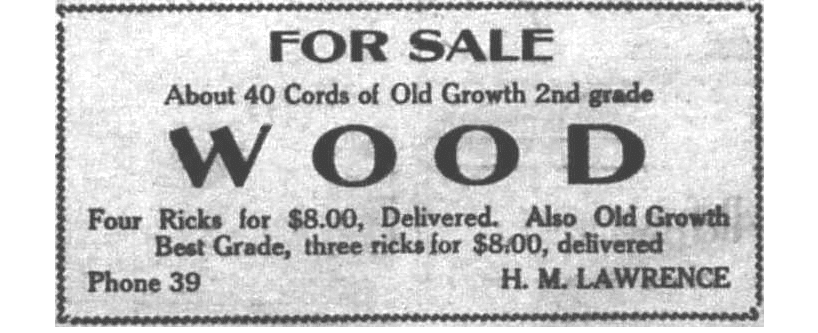
The Bay-Island News, April 8, 1921, page 4.
In the same issue of the newspaper that carried their first cordwood ad, it was noted that Henry had donated a year’s worth of firewood to the Methodist-Episcopal Church in Gig Harbor.
They were still selling cordwood in 1925.

The Bay-Island News, January 2, 1925, page 3.
Advertisements from the same year show that Henry did not give up his carpentry in favor of cordwood cutting.

The Peninsula Gateway, May 22, 1925, page 3.
Barter instead of cash
Trading goods and services instead of buying and selling them was much more common a hundred years ago, and Henry Lawrence provides us with many excellent examples. One of the best raises the question: How many people today would be willing to accept 500 chickens as a down payment on a used truck?
And when’s the last time you saw someone willing to take 100 chickens or a cow as first payment on a house? Or huckleberries or potatoes for Chester White pigs?
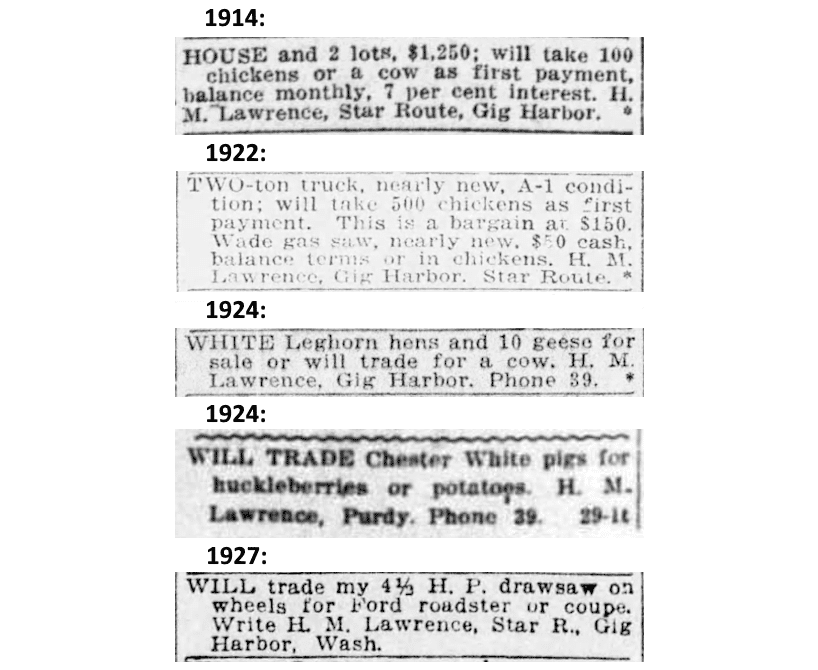
Civic minded
As busy as he was with his various business enterprises, Henry always found time to be very involved with the local schools, both as clerk for the elementary school in Purdy and as a director of the district high school in Gig Harbor.
A milestone event
The year 1925 saw the Lawrence family establish a new business on waterfront property a few hundred feet west of their home. The business was twofold, an auto park (essentially a campground for motorists) and a combination service station/grocery store.

The News Tribune, Sept. 8, 1927, page 15.
The opening of the Lawrence Auto Park received ample newspaper coverage, and appears to have been quite successful.
Appropriately enough, the east-west road between the house and the auto park became known as Lawrence Road.
Lawrence sons on their own
By 1929, an unknown number of the four remaining Lawrence brothers set out on their own. They formed Lawrence Brothers Home Builders and Contractors. Their business telephone number was that of their parents’ home, 39.

The Peninsula Gateway, Aug. 29, 1929.
Soon after, Henry wanted to lease or sell the store and service station at Lawrence Park.

The News Tribune, Nov. 30, 1929, page 13.
The store and gas station didn’t sell, and was being operated by at least two of the Lawrence brothers when it was destroyed by fire late in the evening of Tuesday, July 21, 1931.
The lost business house was not rebuilt. The auto park continued for several more years.
Henry and Ida’s youngest child, Josephine, just 14 when it was destroyed, always had dreams of working in the store. But her mother was very ill and needed her daughter to stay home to help care for her. When the store burned, the dream went up in smoke too.
Another son is lost
Keith Lawrence, another son who was a carpenter, died in 1932 of a stroke while suffering from non-epidemic polio. He was 24, and had been married less than three months.
Refocusing on the building trade
H.M. Lawrence & Son (probably Malcolm), General Jobbers & Carpenters, had two bases of operations in 1933, Gig Harbor and Bremerton.

The Peninsula Gateway, Oct. 6, 1933.
It was not long before Henry and his family suffered another severe loss. At the end of 1935, Ida, his wife of 39 years, died of heart failure.
While his sons and daughters continued their lives in Washington, Henry packed up and moved to Los Angeles in April 1938. Two months later, he married his widowed sister-in-law, Zella Lawrence. She had lost her husband, Henry’s oldest brother, three months after Henry’s wife died. They remained together until his death in 1946.
The Lawrence Road sign
Fast forward to 1997, when Pierce County instituted a numbered grid system for road names to improve response times for police, fire and medical emergencies. Many old roads lost their names in favor of numbers. Lawrence Road was changed to 154th Street NW. The new name did not reflect the history of the area. Josephine Lawrence Campen Roby (Jo), Henry and Ida’s youngest child, was upset, and rightly so. But the change was made, and it was permanent.
Sort of.
A few years later, Carl Campen, Jo’s son and a lifelong Peninsula resident, saw something in Puyallup that gave him an idea.
Atop a standard street name sign, he noticed a brown sign with white letters that gave the historic name of the road. Through some online research, he learned that it was possible to restore the name of 154th St. NW to Lawrence Road by means of one of the brown-background signs, without actually changing the name from the strictly practical 154th Street.
Carl’s mother was thrilled. The Lawrence name was going to be restored to the road where she had grown up.
As with most things government-related, it was a slow, involved process. The road belongs to Pierce County, while the stop sign post the new legacy name sign would be mounted atop is on Washington state land, being both an onramp to, and exit from, Highway 16.
Carl had to coordinate his request between the highway and road departments of the state and Pierce County. Plus, he had to pay for the sign himself.
Two years later, in 2009, the deed was done. It was the first historic road name sign on the Peninsula. Unfortunately, Jo passed away during the lengthy process, and never got to see it.
One more time
In the summer of 2025, Carl noticed the legacy Lawrence Road sign was missing. What happened to it was never determined. It needed to be replaced, so Carl began the process again. This time it was much, much shorter, as the sign was a replacement rather than a new installation that needed multiple approvals.
Carl credits Pierce County Traffic Operations Supervisor Rick Butner for getting the new sign made and delivered to the Port Orchard office of the Washington state Department of Transportation for installation. That was accomplished on Oct. 14.
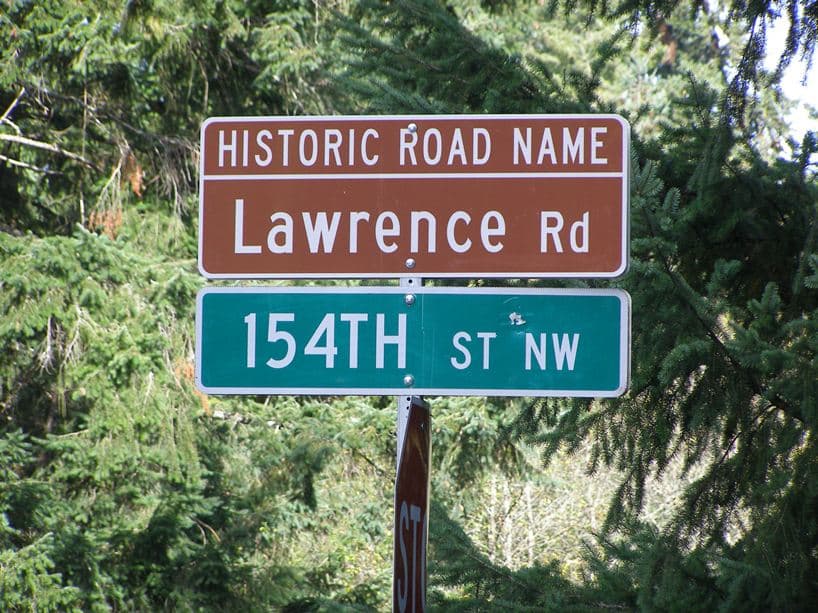
Pierce County Traffic Operations Supervisor Rick Butner saw to it that the missing Lawrence Road sign on 154th Street was replaced after Carl Campen notified him the old one was missing. Photo by Greg Spadoni.
The Historic Road Sign project is now administered by the Pierce County Landmarks & Historic Preservation Commission. The criteria and application process is described in the last two pages of this document.
More Lawrence family recognition
Jo herself helped to preserve the memory of the Lawrence family of Purdy when she saved several items from the Lawrence Auto Park Grocery, and many years later donated them to the Harbor History Museum. The large, round tin of Superior Red Arrow Salted Wafers is currently on display in the museum’s main gallery.
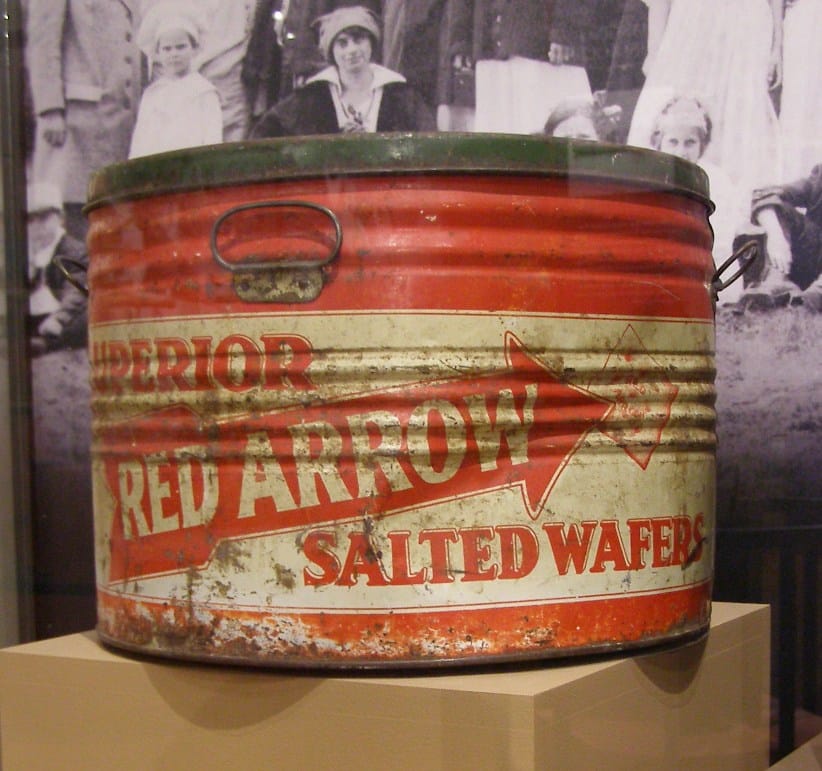
Photo by Greg Spadoni.
Old business
Last time we posted a picture taken by Tonya Strickland and asked, What is it? Where is it? What does it mean?
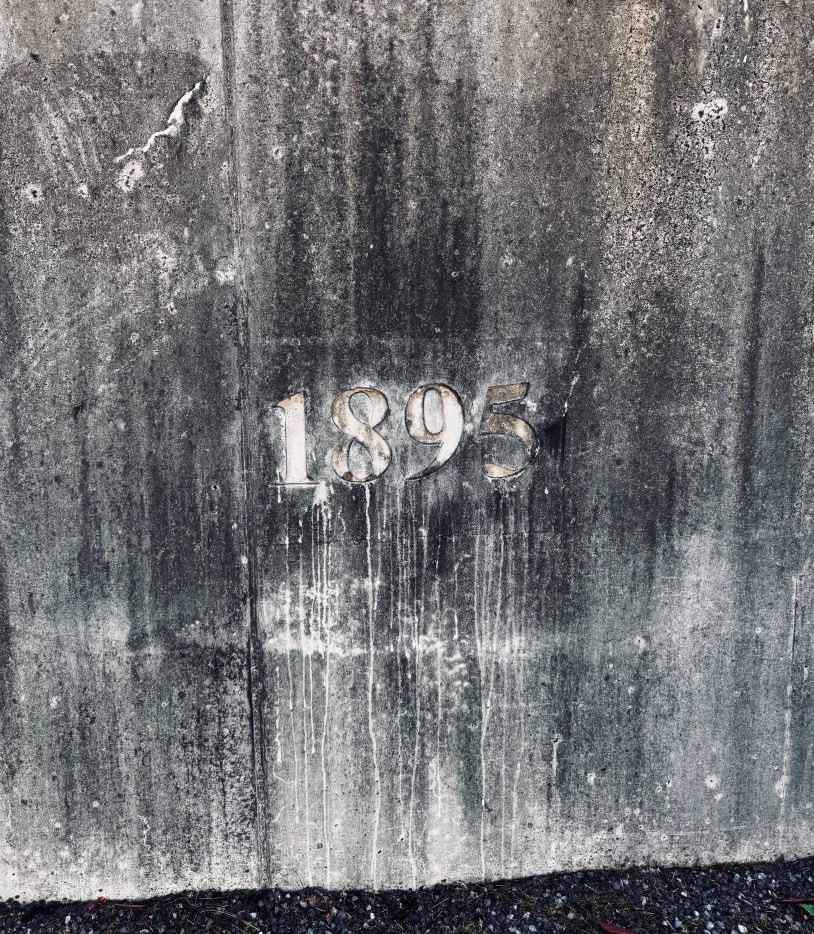
Photo by Tonya Strickland.
Cast into the concrete retaining wall of the Artondale Cemetery on Hunt Road, it is the year the cemetery was dedicated to the public (not the year the retaining wall was poured).
Next time
The next Gig Harbor Now and Then column will be on Dec. 1. The subject has not yet been determined, simply because there are too many to choose from. Well, that and a certain measure of laziness, I suppose.
— Greg Spadoni, November 17, 2025
Greg Spadoni of Olalla has had more access to local history than most life-long residents. During 25 years in road construction working for the Spadoni Brothers, his first cousins, twice removed, he traveled to every corner of the Gig Harbor and Key Peninsulas, taking note of many abandoned buildings, overgrown farms, and roads that no longer had a destination. Through his current association with the Harbor History Museum in Gig Harbor as the unofficial Chief (and only) Assistant to Linda McCowen, the Museum’s primary photo archive volunteer, he regularly studies the area’s largest collection of visual history. Combined with the print history available at the museum and online, he has uncovered countless stories of long-forgotten local people and events.

